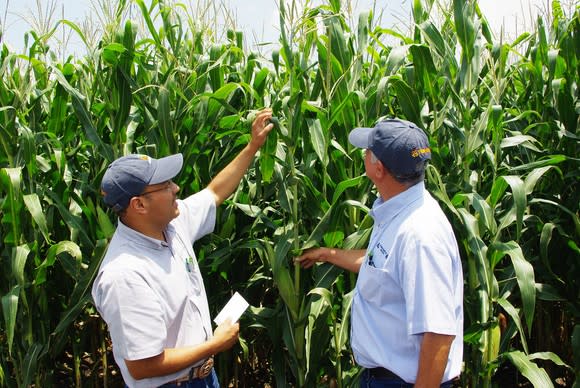Flat Sales Can't Hold Back Monsanto's Profit Growth
Agriculture is a key industry across the globe, and Monsanto (NYSE: MON) has developed a worldwide presence for its seeds, genomic traits, and agricultural productivity products. For more than a year and a half, Monsanto has been waiting to see whether an acquisition proposal from Bayer would gain the necessary approvals to move forward, and the company is still optimistic about its prospects. Yet the uncertainty has distracted investors' attention to some extent from the fundamentals of Monsanto's business.
Coming into Thursday's fiscal first-quarter report, Monsanto investors were looking for solid top-line gains that would lead to a doubling in earnings per share for the company. Monsanto's results weren't quite that good, with lagging sales that were essentially flat compared to the previous year's quarter. Yet the company expressed several reasons why 2018 could look more favorable. Let's take a closer look at Monsanto and what its latest results mean for the ag giant going forward.

Image source: Monsanto.
Corn wilts, but soybeans and fertilizers grow
Monsanto's fiscal first-quarter results weren't everything that the company had hoped for. Revenue inched higher by just a fraction of a percentage point to $2.66 billion, falling well short of the 4% growth rate that most investors were expecting to see. Net income climbed to $169 million, and after making allowances for extraordinary items, adjusted earnings of $0.41 per share were nearly doubled from year-earlier levels. The figure was still $0.01 shy of the consensus forecast among those following the stock.
The big problem for Monsanto's top line came generally from its seeds and genomics business, and within that segment, corn was the big drag on performance. Corn seed and trait revenue plunged 17% to $787 million, more than offsetting a 20% rise in soybean seed and trait sales. Performance elsewhere was mixed, with cotton sales inching higher but sales of seed and traits for vegetable and other crops falling. Monsanto said that lower volumes, especially in the U.S., held back the corn market, but the company expects to recover some of the shortfall later in the fiscal year. Meanwhile, it highlighted the soybean-related gains, with moves to the new Intacta RR2 Pro line in South America accelerating nicely. From a profitability standpoint, the segment did well, with pre-tax profit climbing by more than half for seeds and genomics.
A recovery in the agricultural productivity business also helped Monsanto. Revenue climbed more than 10% to $888 million, and gross profit jumped by more than half. Price improvements helped the company nearly triple its pre-tax profit, and expectations are for sales of XtendiMax herbicides to rise in line with the continued adoption of soybean seed and traits during the period.
CEO Hugh Grant kept investor attention focused on business at hand. "Even with the Bayer combination on the horizon," Grant said, "our teams have maintained their focus on the business and our customers." The CEO also noted the success of its most recent technologies along with continuing efforts to innovate.
What's ahead for Monsanto?
Most of what Monsanto talked about regarding the future was tied to its research and development pipeline. In a separate release, the company pointed to its extensive pipeline of projects aimed to help agricultural professionals handle threats to their crops. Some of the most important projects in Monsanto's eyes include protecting cotton from lygus, thrips, and fleahopper bugs; saving corn from worms and corn borers; NemaStrike technology to fight against parasitic nematodes; and new formulations and combinations of existing weed killers. Monsanto also is using artificial intelligence to identify diseases more effectively, allowing farmers to take appropriate steps more quickly to combat problems before they become more difficult to address. Other efforts will help boost yields, make farmers more efficient with resources, and make better use of data.
Still, investors are largely flying blind with respect to the immediate future for Monsanto. The company expects pre-tax income to grow in fiscal 2018, but it has still chosen not to offer financial guidance due to the pending Bayer merger. Tax reform in the U.S. should also help Monsanto's cost structure beginning in fiscal 2019, and the company is still looking at whether more immediate positive impacts could occur.
Monsanto investors seemed to take the report in stride, and the stock didn't make any major moves in pre-market trading following the announcement. Until more news comes out about the Bayer merger, Monsanto investors will have to wait and see whether growth plans will get a boost from being part of a larger institution going forward.
More From The Motley Fool
Dan Caplinger has no position in any of the stocks mentioned. The Motley Fool has no position in any of the stocks mentioned. The Motley Fool has a disclosure policy.

 Yahoo Finance
Yahoo Finance 